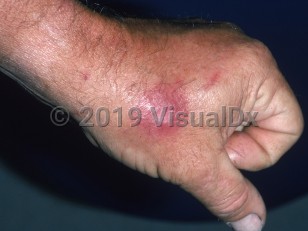Coccidioidomycosis
Alerts and Notices
Important News & Links
Synopsis

Coccidioidomycosis, also known as desert fever, San Joaquin Valley fever, valley fever, or desert rheumatism, is a deep fungal infection caused by the dimorphic fungi Coccidioides immitis and Coccidioides posadasii acquired via the respiratory route.
Coccidioidomycosis is endemic in the southwestern United States (with many cases in Arizona, the San Joaquin Valley in California, New Mexico, and west Texas), with sporadic cases in places where the disease is not endemic (some cases may be due to reactivation of infection acquired in an endemic area). In 2016, rates of coccidioidomycosis increased in California, primarily affecting residents of the Central Valley and Central Coast regions. While individuals aged 40-59 years had the highest incidence, the largest increase in incidence throughout the United States (compared with 2015) occurred in persons younger than 40 and, in particular, younger than 20, with an overall incidence of 15.2 cases per 100 000 (as high as 142.3 per 100 000 in Arizona) with the majority of cases from Arizona and California (97%).
Of infected individuals, approximately one-half to two-thirds are asymptomatic. The remaining infected individuals develop an acute or subacute community-acquired pneumonia 1-3 weeks after exposure. The clinical presentation includes dry cough, pleuritic chest pain, myalgia, arthralgia, fever, sweats, anorexia, and weakness. An exanthematous eruption, erythema multiforme, and erythema nodosum may accompany primary pulmonary infection. Infection is typically self-limited, lasting weeks, and can resolve without therapy. The illness is often indistinguishable from common bacterial or viral pneumonias, although marked fatigue may persist for weeks to months following illness. As a consequence of infection, 5%-10% may develop pulmonary nodules.
Of those symptomatic, 1 in 200 will develop extrapulmonary disease that can spread via hematogenous dissemination to subcutaneous tissues, bone, skin, and meninges. Disease dissemination appears to be more common in Black individuals or individuals of Filipino ancestry than in White individuals but is markedly higher in the immunocompromised host (30%-50% chance of dissemination). Disseminated disease may run a remittent or fulminant course and progress to miliary lung granulomas, meningitis, and hydrocephalus. The mortality rate is greater than 90% after 1 year without therapy. Meningitis requires lifelong therapy to prevent relapse and associated morbidity / mortality.
Primary inoculation coccidioidomycosis is rare and is generally self-limited but may rarely be complicated by meningitis or miliary lung granulomas.
Pregnant individuals may be at increased risk of severe illness from coccidioidomycosis. Coccidioidomycosis acquired during the latter half of pregnancy is more likely to disseminate.
Coccidioidomycosis is endemic in the southwestern United States (with many cases in Arizona, the San Joaquin Valley in California, New Mexico, and west Texas), with sporadic cases in places where the disease is not endemic (some cases may be due to reactivation of infection acquired in an endemic area). In 2016, rates of coccidioidomycosis increased in California, primarily affecting residents of the Central Valley and Central Coast regions. While individuals aged 40-59 years had the highest incidence, the largest increase in incidence throughout the United States (compared with 2015) occurred in persons younger than 40 and, in particular, younger than 20, with an overall incidence of 15.2 cases per 100 000 (as high as 142.3 per 100 000 in Arizona) with the majority of cases from Arizona and California (97%).
Of infected individuals, approximately one-half to two-thirds are asymptomatic. The remaining infected individuals develop an acute or subacute community-acquired pneumonia 1-3 weeks after exposure. The clinical presentation includes dry cough, pleuritic chest pain, myalgia, arthralgia, fever, sweats, anorexia, and weakness. An exanthematous eruption, erythema multiforme, and erythema nodosum may accompany primary pulmonary infection. Infection is typically self-limited, lasting weeks, and can resolve without therapy. The illness is often indistinguishable from common bacterial or viral pneumonias, although marked fatigue may persist for weeks to months following illness. As a consequence of infection, 5%-10% may develop pulmonary nodules.
Of those symptomatic, 1 in 200 will develop extrapulmonary disease that can spread via hematogenous dissemination to subcutaneous tissues, bone, skin, and meninges. Disease dissemination appears to be more common in Black individuals or individuals of Filipino ancestry than in White individuals but is markedly higher in the immunocompromised host (30%-50% chance of dissemination). Disseminated disease may run a remittent or fulminant course and progress to miliary lung granulomas, meningitis, and hydrocephalus. The mortality rate is greater than 90% after 1 year without therapy. Meningitis requires lifelong therapy to prevent relapse and associated morbidity / mortality.
Primary inoculation coccidioidomycosis is rare and is generally self-limited but may rarely be complicated by meningitis or miliary lung granulomas.
Pregnant individuals may be at increased risk of severe illness from coccidioidomycosis. Coccidioidomycosis acquired during the latter half of pregnancy is more likely to disseminate.
Codes
ICD10CM:
B38.9 – Coccidioidomycosis, unspecified
SNOMEDCT:
60826002 – Coccidioidomycosis
B38.9 – Coccidioidomycosis, unspecified
SNOMEDCT:
60826002 – Coccidioidomycosis
Look For
Subscription Required
Diagnostic Pearls
Subscription Required
Differential Diagnosis & Pitfalls

To perform a comparison, select diagnoses from the classic differential
Subscription Required
Best Tests
Subscription Required
Management Pearls
Subscription Required
Therapy
Subscription Required
References
Subscription Required
Last Reviewed:03/20/2023
Last Updated:04/06/2023
Last Updated:04/06/2023

